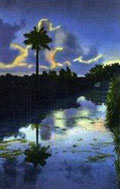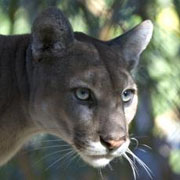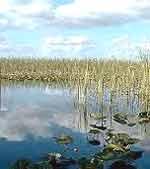VOA慢速英语2011--Everglades National Park – One of the World’s Great Biological Wonders
时间:2018-12-16 作者:英语课 分类:2011年VOA慢速英语(十)月
SCIENCE IN THE NEWS - Everglades National Park – One of the World’s Great Biological Wonders
STEVE EMBER: This is SCIENCE IN THE NEWS, in VOA Special English. I’m Steve Ember.
FAITH LAPIDUS: And I’m Faith Lapidus. This week, we tell about Everglades National Park in the American state of Florida.
(MUSIC)
STEVE EMBER: When many people think of Florida, images of sandy coastlines or fun theme park rides come to mind. Yet about an hour south of Miami lies a natural wilderness 1 different from anywhere else in the United States.
Everglades National Park is the largest subtropical wilderness in the country. The park is home to several rare and endangered species. It is also the third largest national park in the lower forty-eight states, after Death Valley and Yellowstone. Each year, more than one million people visit the Everglades.
FAITH LAPIDUS: In nineteen forty-seven, President Harry 2 Truman spoke 3 at the official opening of Everglades National Park. He said the goal of creating the park was to protect forever a wild area that could never be replaced.

A great egret is one of many species that lives within the Everglades National Park
The Everglades is considered one of the great biological wonders of the world. The expansive wetlands stretch across more than six hundred thousand hectares. It is a place where plants and animals from the Caribbean Sea share an ecosystem 4 with native North American species.
Nine different environments exist within the Everglades. They include mangrove 5 and cypress 6 swamps, estuaries 7 and coastal 8 marshes 9.
(MUSIC)
STEVE EMBER: In the nineteen-forties, Marjory Stoneman Douglas wrote a book called, “The Everglades: River of Grass.” She described the area as, “the liquid heart of Florida.”
Unlike most other national parks, Everglades National Park was created to protect an ecosystem from damage. The Everglades is home to about fifteen species that federal officials say are threatened and endangered. They include the Florida panther, the American crocodile and the West Indian manatee 10.

The Everglades at dusk
In addition, more than three hundred fifty bird species and three hundred species of fresh and saltwater fish live within the park. The Everglades is also home to forty species of mammals and fifty reptile 11 species.
FAITH LAPIDUS: Visitors to the Everglades will see many exotic plants. They include what is said to be the largest growth of mangrove trees in the western world. Gumbo-limbo trees, known for their peeling red skin, strangler figs 12 and royal palms are also among the area’s plant life. The country’s largest living mahogany tree also lives in the Everglades.
Sawgrass grows in some areas of the park. Be careful – sawgrass is very sharp, with teeth just like a saw. It can grow up to four meters tall.
With about one and one-half meters of rainfall each year, plants and trees never stop growing in the Everglades.
(MUSIC)

A Florida Panther
STEVE EMBER: The dry, winter season is the favorite of most visitors, when insects like mosquitoes are less of a problem. The rainy season lasts from June to November. There are many ways to explore the Everglades. Visitors can see alligators 14 while hiking the Anhinga Trail.
The Everglades is one of the only places on Earth where freshwater alligators and saltwater crocodiles live in the same area. Visitors using canoes or airboats are likely to see large groups of wading 15 birds like the wood stork 16 or the great blue heron. It is even possible to see flamingos 17 in the Everglades.
Some visitors might enjoy riding bicycles through Shark Valley. Others may want to move slowly through shallow waters where they can see insects and wildlife up-close. Park guides also lead visitors on tram rides.

An American Alligator 13
FAITH LAPIDUS: Experts say changes to the Everglades are threatening several different kinds of wildlife. They say the threats are a result of actions the United States government began more than fifty years ago, and settlers began even earlier.
The National Park Service says that early colonial settlers and land developers believed the Everglades had little value. The settlers had plans to remove water from the area. In the eighteen eighties, developers began digging canals to reduce water levels.
At the time, they did not understand the complexity 18 of the Everglades’ ecosystem. As a result, they were not prepared for all the work and caused environmental problems. The ecosystem, however, was able to survive.
STEVE EMBER: Even larger efforts to drain the wetlands continued between nineteen oh five and nineteen ten. Farms were built on large pieces of land. This led to increased development, with more people moving to the Everglades and also more visitors.
More changes came in nineteen forty-eight. At that time, Congress approved the Central and South Florida Project. As part of the plan, the Army Corps 19 of Engineers built roads, canals and water-control systems throughout South Florida.
The aim of the project was to provide water and flood protection for developed areas and agriculture. Workers built a huge system of waterways and pumping stations to control the overflow 20 of Lake Okeechobee, north of the Everglades.
FAITH LAPIDUS: Today, fifty percent of South Florida’s early wetland areas no longer exist. Populations of wading birds have been reduced by ninety percent. Whole populations of animals are in danger of disappearing. The endangered creatures include the manatee, the Miami blackhead snake, the wood stork and the Florida panther.
In recent years, environmental experts have learned about the damage to the Everglades. They say the balance of nature there has been destroyed.
(MUSIC)
STEVE EMBER: About ten years ago, Congress approved a plan to restore and improve the Everglades. Federal, state and other organizations are partners in the Comprehensive Everglades Restoration Plan. The project is expected to cost about twelve billion five hundred million dollars.
 Early in two thousand ten, work began on the Picayune Strand 21 Restoration Project. A goal of the project is to re-establish natural water flow across more than twenty-two thousand hectares of land. Workers removed water from that area in the early nineteen sixties. At the time, the goal was to develop the land of Picayune Strand for homes. However, the development harmed healthy wetlands.
Early in two thousand ten, work began on the Picayune Strand 21 Restoration Project. A goal of the project is to re-establish natural water flow across more than twenty-two thousand hectares of land. Workers removed water from that area in the early nineteen sixties. At the time, the goal was to develop the land of Picayune Strand for homes. However, the development harmed healthy wetlands.
FAITH LAPIDUS: Project organizers hope to re-create wetlands in Picayune Strand and nearby lands by redirecting the flow of water in that area. At the same time, they are seeking to re-establish natural water flow to the Ten Thousand Islands National Wildlife refuge.
Goals of the project are to make major additions to the size and improve wetland ecosystems 22 in nearby lands. The area includes the Collier Seminole State Park and the Florida Panther National Wildlife Refuge. If the goals are met, the project should help threatened and endangered animals.
STEVE EMBER: For example, the population of one big cat has been falling in recent years. Panthers once existed in much greater numbers. But too much hunting, loss of panther homelands and vehicle strikes have reduced their population. Fewer than one hundred of the animals now live in Florida.
FAITH LAPIDUS: Wildlife experts are working to increase the number of panthers and other animals at risk. At the same time, biologists are attempting to remove Burmese pythons. Officials believe there are as many as one hundred fifty thousand of these large snakes in the Everglades.
However, the snakes are a foreign species, native to Southeast Asia. Owners of pythons left their unwanted snakes in the Everglades years ago. Biologists say adult pythons are able to eat small deer and bobcats. When pythons are found in the Everglades, they are often killed.
Scientists are now experimenting with other ways to remove the snakes, including use of traps and offering payments to hunters.
STEVE EMBER: The future of the Everglades is not clear. However, efforts to protect the area are continuing so people from all over the world may continue visiting this biological treasure.
(MUSIC)
FAITH LAPIDUS: This SCIENCE IN THE NEWS was written by Brianna Blake and Jerilyn Watson. Our producer was June Simms. I’m Faith Lapidus.
STEVE EMBER: And I’m Steve Ember. Read and listen to our programs at voanews.cn. And you can see videos about Everglades National Park and projects to protect and improve the park at www.evergladesplan.org. Join us again next week for more news about science in Special English on the Voice of America.
- She drove the herd of cattle through the wilderness.她赶着牛群穿过荒野。
- Education in the wilderness is not a matter of monetary means.荒凉地区的教育不是钱财问题。
- Today,people feel more hurried and harried.今天,人们感到更加忙碌和苦恼。
- Obama harried business by Healthcare Reform plan.奥巴马用医改掠夺了商界。
- They sourced the spoke nuts from our company.他们的轮辐螺帽是从我们公司获得的。
- The spokes of a wheel are the bars that connect the outer ring to the centre.辐条是轮子上连接外圈与中心的条棒。
- This destroyed the ecosystem of the island.这样破坏了岛上的生态系统。
- We all have an interest in maintaining the integrity of the ecosystem.维持生态系统的完整是我们共同的利益。
- It is the world's largest tidal mangrove forest.它是世界上最大的红树林沼泽地。
- Many consider this the most beautiful mangrove forest in all Thailand.许多人认为这里是全泰国最美丽的红树林了。
- The towering pine and cypress trees defy frost and snow.松柏参天傲霜雪。
- The pine and the cypress remain green all the year round.苍松翠柏,常绿不凋。
- We also recognize the diversity and complexity of controlling in fluences in estuaries. 我们也认识到在河湾内控制影响的多样性和复杂性。
- Estuaries also contribute to economy through tourism and fishing. 河口还为人类提供了休闲和教育的场所。
- The ocean waves are slowly eating away the coastal rocks.大海的波浪慢慢地侵蚀着岸边的岩石。
- This country will fortify the coastal areas.该国将加强沿海地区的防御。
- Cows were grazing on the marshes. 牛群在湿地上吃草。
- We had to cross the marshes. 我们不得不穿过那片沼泽地。 来自《简明英汉词典》
- We watched dolphin,manatee,sea lion and whale shows.我们看了海豚、海牛、海狮和鲸的表演。
- One of the most extraordinary river creatures is Amazonian manatee.其中河里最特别的生物之一要数亚马孙海牛。
- The frog is not a true reptile.青蛙并非真正的爬行动物。
- So you should not be surprised to see someone keep a reptile as a pet.所以,你不必惊奇有人养了一只爬行动物作为宠物。
- The effect of ring dyeing is shown in Figs 10 and 11. 环形染色的影响如图10和图11所示。
- The results in Figs. 4 and 5 show the excellent agreement between simulation and experiment. 图4和图5的结果都表明模拟和实验是相当吻合的。
- She wandered off to play with her toy alligator.她开始玩鳄鱼玩具。
- Alligator skin is five times more costlier than leather.鳄鱼皮比通常的皮革要贵5倍。
- Two alligators rest their snouts on the water's surface. 两只鳄鱼的大嘴栖息在水面上。 来自辞典例句
- In the movement of logs by water the lumber industry was greatly helped by alligators. 木材工业过去在水上运输木料时所十分倚重的就是鳄鱼。 来自辞典例句
- The man tucked up his trousers for wading. 那人卷起裤子,准备涉水。
- The children were wading in the sea. 孩子们在海水中走着。
- A Fox invited a long-beaked Stork to have dinner with him.狐狸请长嘴鹳同他一起吃饭。
- He is very glad that his wife's going to get a visit from the stork.他为她的妻子将获得参观鹳鸟的机会感到非常高兴。
- Flamingos stand in a salt lake in Larnaca, Cyprus. 塞浦路斯的拉纳卡市一个盐湖中的火烈鸟。 来自互联网
- The research started researchers studied greater flamingos and in a bird sanctuary in southern Spain. 研究人员在西班牙南部的一个鸟类保护区对大型火烈鸟进行研究。 来自互联网
- Only now did he understand the full complexity of the problem.直到现在他才明白这一问题的全部复杂性。
- The complexity of the road map puzzled me.错综复杂的公路图把我搞糊涂了。
- The medical corps were cited for bravery in combat.医疗队由于在战场上的英勇表现而受嘉奖。
- When the war broke out,he volunteered for the Marine Corps.战争爆发时,他自愿参加了海军陆战队。
- The overflow from the bath ran on to the floor.浴缸里的水溢到了地板上。
- After a long period of rain,the river may overflow its banks.长时间的下雨天后,河水可能溢出岸来。
- She tucked a loose strand of hair behind her ears.她把一缕散发夹到了耳后。
- The climbers had been stranded by a storm.登山者被暴风雨困住了。
- There are highly sensitive and delicately balanced ecosystems in the forest. 森林里有高度敏感、灵敏平衡的各种生态系统。 来自《简明英汉词典》
- Madagascar's ecosystems range from rainforest to semi-desert. 马达加斯加生态系统类型多样,从雨林到半荒漠等不一而足。 来自辞典例句